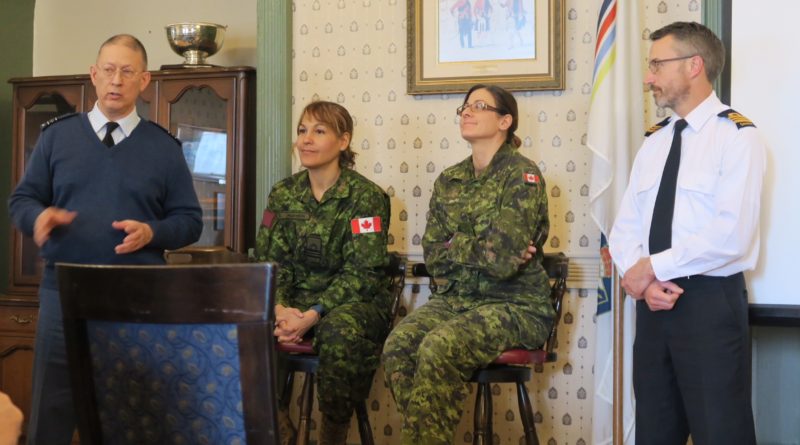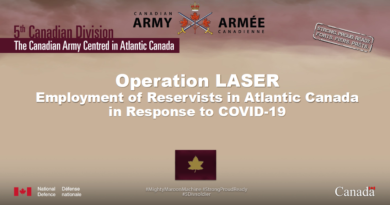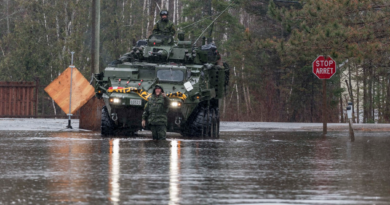The changing nature of public affairs in the CAF
(Editor’s note: Senior Public Affairs Officers [PAO] Major James Simiana, National Defence Public Affairs Officer Atlantic; Lieutenant-Commander Jordan Holder, PAO Maritime Forces Atlantic; Lieutenant-Commander Kelly Williamson, PAO 5th Canadian Division; and Major Amber Bineau, PAO Joint Task Force Atlantic, spoke to RUSI(NS) and guests 21 February about their experiences as deployed PAO in operations, exercises and activities abroad and at home, including NATO, eastern Europe, off the coasts of Africa, and the Arctic. They spoke with few slides or notes. Their talks were well captured by reporter Ryan Melanson and published 5 March 2018 by the Trident, newspaper of Maritime Forces Atlantic [https://tridentnewspaper.com/wp-content/uploads/2018/03/2018-03-05-05.pdf]. This article is reproduced with permission.)
Military public affairs officers normally prefer to stay out of the spotlight, but that wasn’t the case on February 21, as four senior PAOs from local offices spoke about their jobs to a group of retired military members and other stakeholders.
“The nature of public affairs has been changing over the course of recent decades, and our role in supporting operations has also changed. PA now has a big role to play in enabling and achieving strategic operational success,” said LCdr Jordan Holder, senior MARLANT PAO, to members of the Royal United Services Institute of Nova Scotia gathered at the RA Park Officers’ Mess. LCdr Holder spoke alongside Maj Amber Bineau of JTFA, LCdr Kelly Williamson of 5 Cdn Div, and Maj James Simiana of NDPAO Atlantic.
LCdr Holder referenced recent deployments where PA messaging, and the strategic intent behind it, was important to achieving mission objectives. During Op LENTUS in 2017 in response to ice storms in New Brunswick, a key goal was to use the CAF’s presence as a reminder to locals that the federal government was aware of their plight and ready to help.
“The key for us in communications is ensuring that people are aware of our ability to provide for their safety and security. So during that ice storm, it was critical that the people of New Brunswick knew we were there,” he said, and PA used all avenues to achieve that. In some cases, the knowledge that help had arrived was as important as the actual work being carried out.
“If people don’t think the government is there, looking after them, they might lose confidence in the government’s ability to do that.”
During overseas operations, often in highly-politicized environments, new hybrid warfare strategies involve our adversaries pushing out messages that seek to delegitmize governments, or introduce misinformation into the discourse to confuse the public and change narratives. Communications through PA is also a big part of countering that, LCdr Holder said.
And as advances in technology continue to change common forms of communication, PAOs have adapted and now include social media as one of their most critical tools for sending out information. Platforms like Twitter and Facebook have been especially useful in emergency or breaking news scenarios, when the media and public need details quickly. Maj Simiana gave the example of a crash during a training flight at 15 Wing Moose Jaw in early 2017, when the student and instructor were forced to carry out a controlled ejection.
“Media monitor police and fire channels, and that got picked up very quickly,” he said, forcing PA personnel to react, and the first news of the crash and pilot and instructor’s safety was sent via tweet just minutes after the event.
And in an example of situation occurring while deployed abroad, LCdr Williamson recalled her deployment with DART following a devastating Earthquake in Nepal in 2015. When a second earthquake knocked out power and caused a new round of panic and confusion, determining the safety of CAF members and other Canadians in the country, and communicating that to the public, became a top priority.
“Again, we ended up using social media to put out that first ‘All Canadian are safe ‘ message, right from theatre as it happened,’” she said.
As traditional news media struggles as an industry and reporters become less specialized, these digital mediums are also used increasingly to keep the public informed about all aspects of the CAF in a strategic way, including as a recruitment tool. CAF accounts strive to send out messaging that can be relatable to younger audiences, and in a recent case, a social media influencer in the Toronto area was invited by PA to CFB Borden to shoot video and vlog to her followers while touring the base. The result was an immediate boost in web traffic for the local recruiting group.
Whether in support of domestic or international operations or areas like recruitment and public engagement, the PA branch increasingly sees itself as one aspect of Strategic Command, along with other enablers like military diplomacy and PsyOps. This doesn’t negate the traditional PA function of providing truthful information about Canada’s military and being accountable to Canadians, but rather recognizes the reality that strategic impact should be considered anytime information is pushed to the public, Maj Simiana said.
“The moment you inform somebody is the moment you can influence then, whether you intend to or not.”
A PDF of this report is available here.



